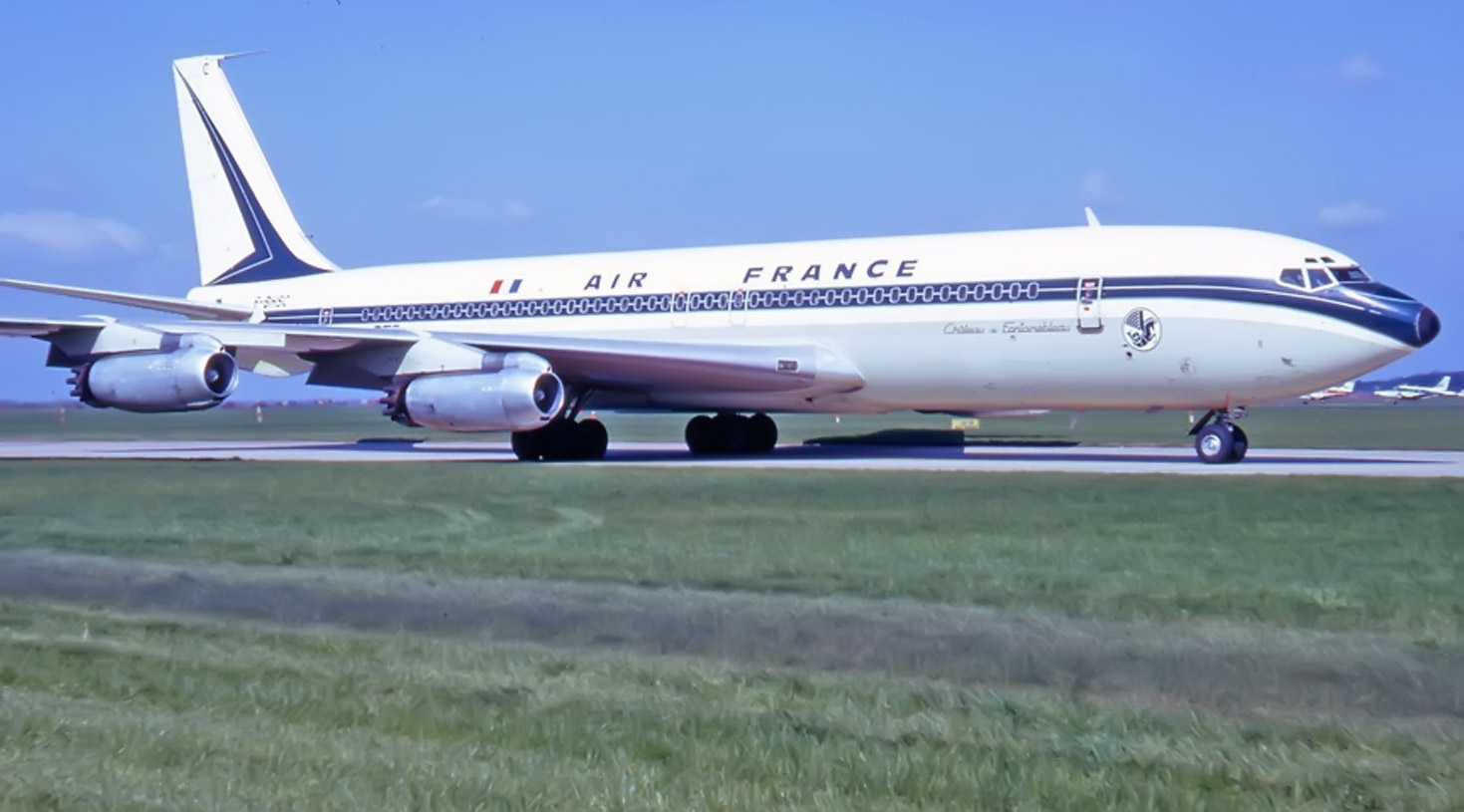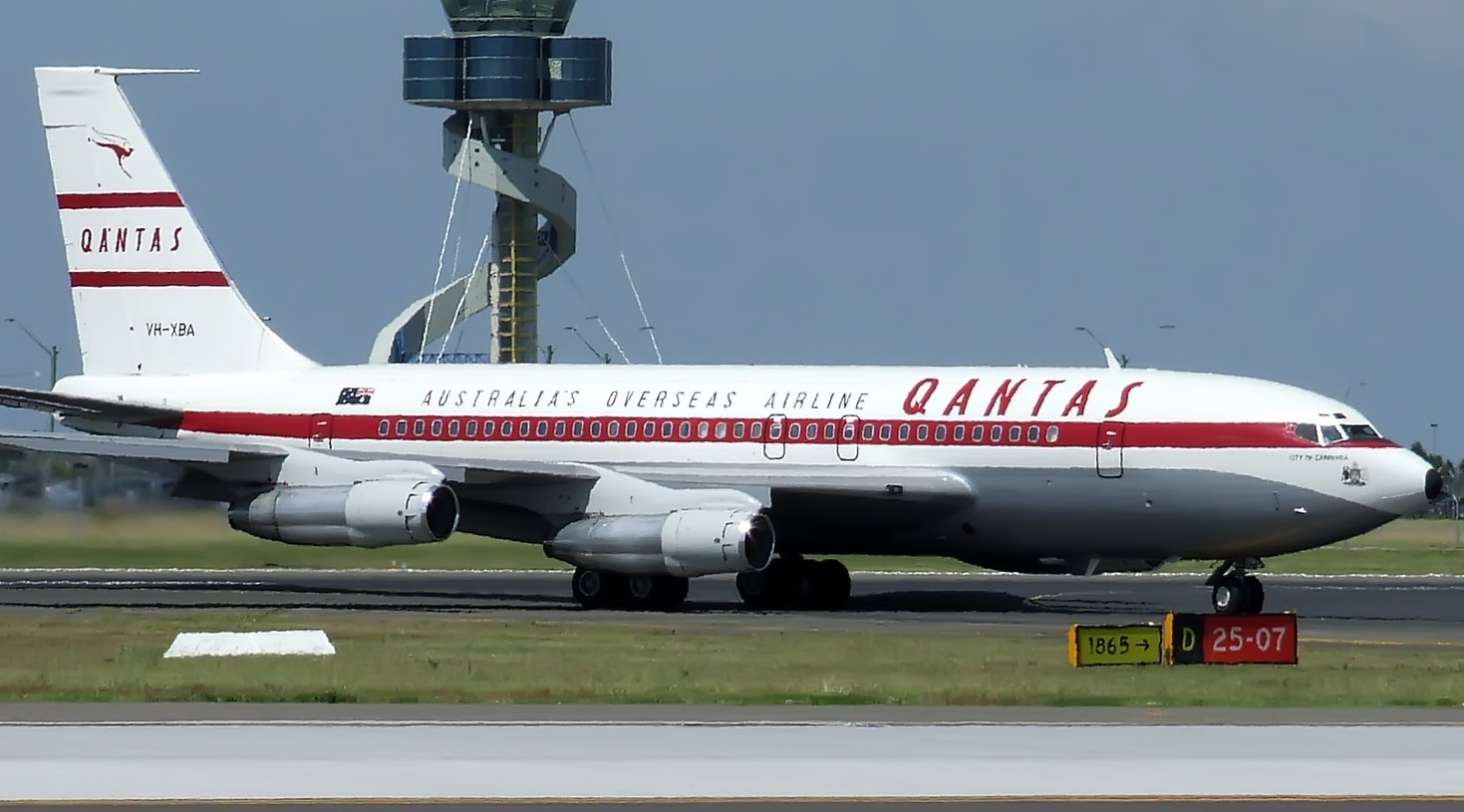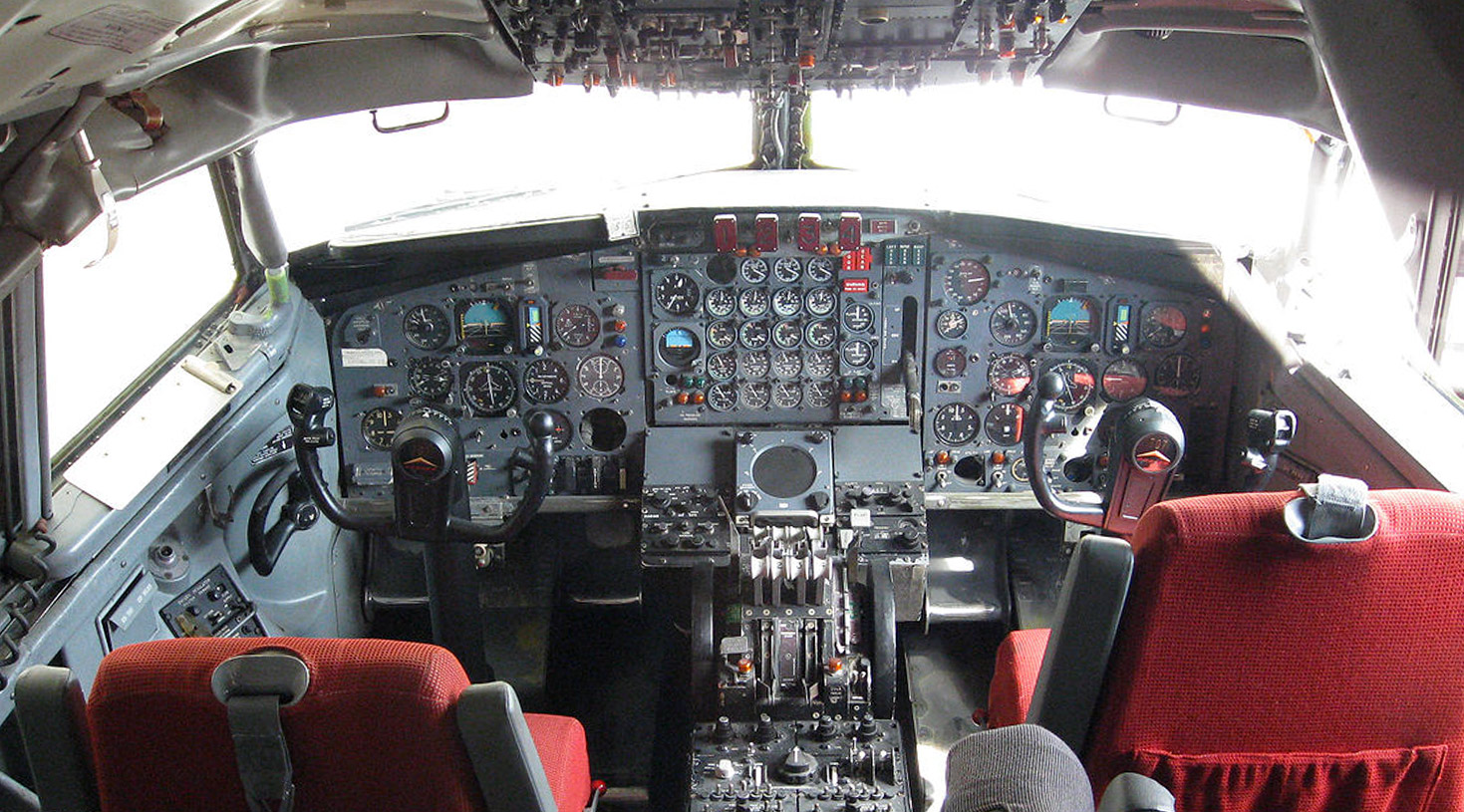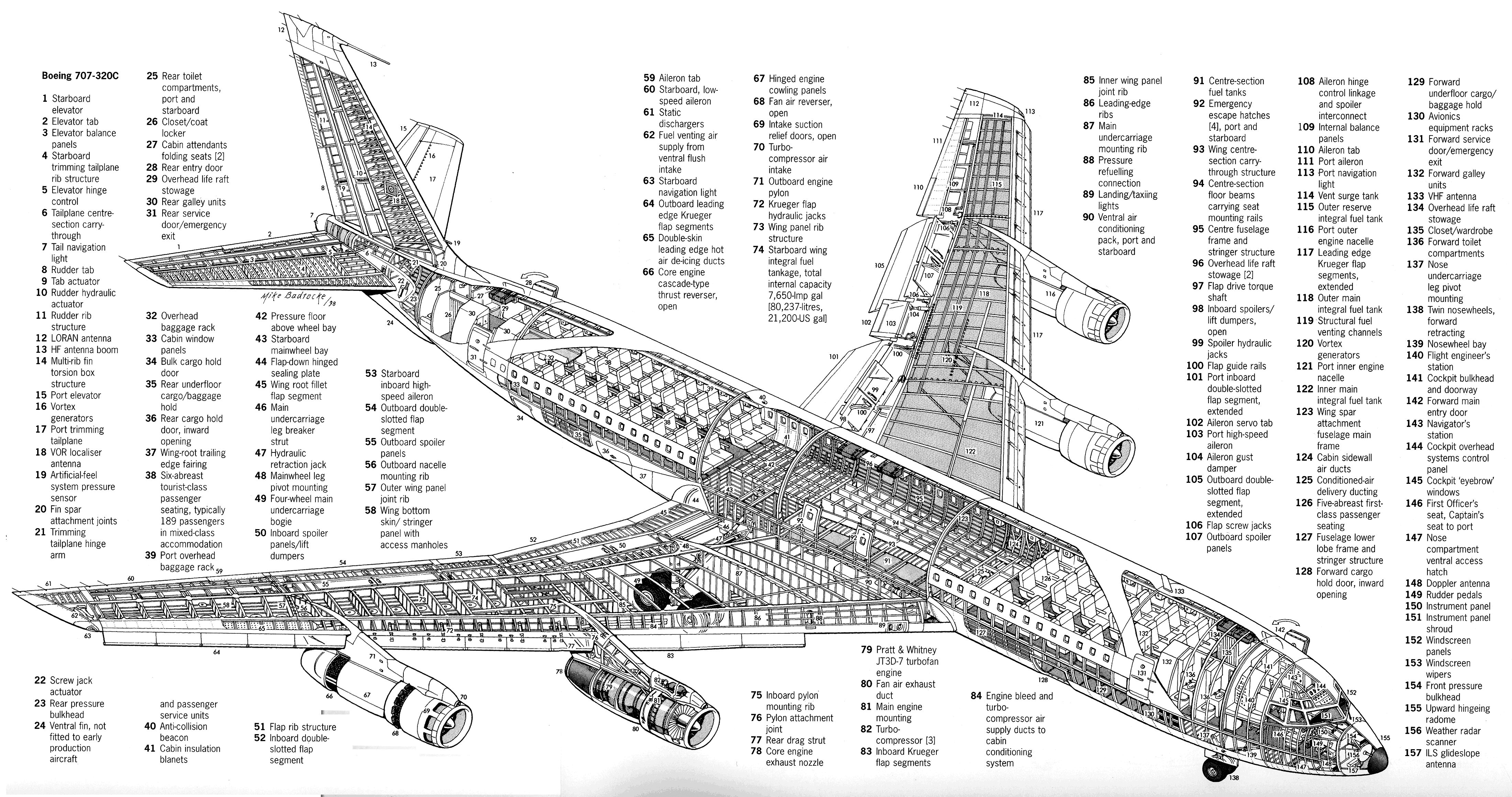Price: $19.95
- 5 magazines, 5 manuals, & photos
- PDF contains 2,620 pages
- Content is keyword searchable
- Print a personal copy
- Pay via PayPal or Credit Card
- International orders welcome!
- Download files upon payment
January 1987
- Aerial Refueling with the Air National Guard
- Fought’s Marauder Strikefighter
- Great Pan-Am Clippers, Sikorsky S-42, Martin M-130, and Boeing 314
April 1993
- Clipped Wings, the Future of American Aerospace
- Supersonic Spearhead, Convair’s B-58 Hustler
- Flying Terminated Inventory
May 2004
- Boeing’s Dash 80 – Was it the airplane that changed the world?
- 1950s Air Force Missiles
- F7F Tigercats – Night Fighers in Korea
August 2004
- Boeing 707 – America’s First Jetliner!
- Andre Tupolev – From Prison to Flightline: An incredible story of survival!
- Golden age of Aviation Advertising
- Was there an Army Air Force Helldiver?
July 2005
- History of InFlight Refueling – From C-1 to KC-10
- WWI ACE! Fighter pilot from the past
- Tail Design – The long and short of it
Manuals & Photos
- 707 Operations Manual
- 707 Reference Guide
- 707 Stewardess Training Guide
- EC-135C Flight Manual
- KC-135A Flight Manual
- Over 150 civilian & military 707 photos
Boeing 707
707 Specifications
Variants
On Display
Cutaway
| 707-120 | 707-320 | 707-120B | 707-320B | |
|---|---|---|---|---|
| Cockpit crew | Three (four with navigator on overwater flights) | |||
| Passengers | 179 allowed (110 typical when new) | 189 allowed | 104 (2-class) 189 (1-class, maximum) |
147 (2-class) 219 (1-class, maximum) |
| Length | 144 ft 6 in (44.04 m) | 152 ft 11 in (46.61 m) | 145 ft 1 in (44.22 m) | 152 ft 11 in (46.61 m) |
| Wingspan | 130 ft 10 in (39.90 m) | 142 ft 5 in (43.41 m) | 130 ft 10 in (39.90 m) | 145 ft 9 in (44.42 m) |
| Tail height | 38 ft 8 in (11.79 m) | 42 ft 5 in (12.93 m) | ||
| Maximum takeoff weight (MTOW) |
247,000 lb (112 037 kg) | 315,000 lb (142 881 kg) | 257,000 lb (116,570 kg) | 333,600 lb (151,320 kg) |
| Empty weight | 109,700 lb (49 760 kg) | 120,000 lb (54 432 kg) | 122,533 lb (55,580 kg) | 146,400 lb (66,406 kg) |
| Runway needed at MTOW | 10,200 ft (3,109 m) | 11,000 ft (3,353 m) | 9,000 ft (2,900 m) | 10,840 ft (3,280 m) |
| Fuel capacity | 13,478 US gal (51,020 L) 710 US gal (2,700 L) water |
21,200 US gal (80,000 L) (no water) |
17,330 US gal (65,600 L) | 23,855 US gal (90,300 L) |
| Landing run | 6,000 ft (1,829 m) | 6,450 ft (1,966 m) | 6,200 ft (1,890 m) | 5,950 ft (1,814 m) |
| Range (with maximum payload) |
2,300 nmi (4,300 km) | 3,875 nmi (7,176 km) | 2,800 nmi (5200 km) | 3,735 nmi (6,920 km) |
| Range at MTOW (with maximum fuel) |
3,750 nmi (6,940 km) | 4,920 nmi (9,110 km) | 4,700 nmi (8,704 km) | 5,750 nmi (10,650 km) |
| Speed | 495 kn (917 km/h; 570 mph) at 28,000 ft (8,500 m) and 180,000 lb (82,000 kg) | 520 kn (960 km/h; 600 mph) at 23,000 ft (7,000 m) and 260,000 lb (120,000 kg) | 526 kn (974 km/h; 605 mph) at 25,000 ft (7,600 m) and 210,000 lb (95,000 kg) | 480 kn (890 km/h; 550 mph) |
| Fuselage width | 12 ft 4 in (3.76 m) | |||
| Powerplants (4 x) | Pratt & Whitney JT3C-6 11,200 lbf (50 kN) dry 13,000 lbf (58 kN) water injection |
Pratt & Whitney JT4A-3s 15,800 lbf (70 kN) dry only |
Pratt & Whitney JT3D-1 17,000 lbf (76 kN) |
PW JT3D-3: 18,000 lbf (80 kN) PW JT3D-7: 19,000 lbf (84.4 kN) |
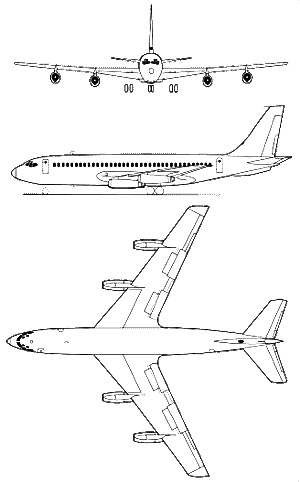
Although certificated as Series 100s, 200s, 300s, etc., the different 707 variants are more commonly known as Series 120s, 220s, 320s, and so on, where the “20” part of the designation is Boeing’s “customer number” for its development aircraft.
707-020
The 707-020 was the original designation for what ultimately became the Boeing 720. Launch customer United Air Lines was a Douglas DC-8 customer and preferred not to be seen as buying the competing 707 hence the 720 designation. American Airlines always referred to its 720s as 707s.
707-120
The 707-120 was the first production 707 variant, with a longer, wider fuselage, and greater wingspan than the Dash-80. The cabin had a full set of rectangular windows and could seat up to 189 passengers. It was designed for transcontinental routes and often required a refueling stop when flying across the North Atlantic. It had four Pratt & Whitney JT3C-6 turbojets, civil versions of the military J57, initially producing 13,000 lb (57.8 kN) with water injection. Maximum takeoff weight was 247,000 lb and first flight was on December 20, 1957. Major orders were the launch order for 20 707-121 aircraft by Pan American and an American Airlines order for 30 707-123 aircraft. The first revenue flight was on October 26, 1958. 56 were built, plus 7 short body ?138s; the last ?120 was delivered to Western in May 1960.
The 707-138 was a ?120 with a fuselage ten feet shorter than the others, with 5 feet (3 frames) removed ahead and behind the wing, giving increased range. Maximum take off weight was the same 247,000 lb as the standard version. It was a variant for Qantas, thus had its customer number 38. The seven ?138s were delivered to Qantas June–September 1959 and first carried passengers that July.
The 707-120B had Pratt & Whitney JT3D-1 turbofan engines, which were quieter, more powerful, and more fuel-efficient, producing 17,000 lbf (75.6 kN) each, with the later JT3D-3 version giving 18,000 lbf (80 kN). (This thrust did not require water injection, eliminating both the system and the 5000–6000 lb weight of the water itself.) The ?120B had the wing modifications introduced on the 720 and a longer tailplane; a total of 72 were built, 31 for American and 41 for TWA, plus 6 short body ?138Bs for Qantas. American had its 23 surviving ?123s converted to 123Bs but TWA did not convert its 15 -131s. The only other conversions were Pan American’s 5 surviving ?121s and one surviving ?139, the 3 aircraft delivered to the USAF as ?153s and the 7 short body Qantas ?138s. The first flight of the ?120B was on June 22, 1960 and American carried the first passengers in March 1961; the last delivery was to American in April 1969. Maximum weight was 258,000 lb (117,025 kg) for both the long and short body versions.
707-220
The 707-220 was designed for hot and high operations with more powerful 15,800 lb (70.80 kN) Pratt & Whitney JT4A-3 turbojets. Five of these were produced, but only four were ultimately delivered with one being lost during a test flight. All were for Braniff International Airways and carried the model number 707-227; the first entered service in December 1959. This version was made obsolete by the arrival of the turbofan-powered 707-120B.
707-320
The 707-320 Intercontinental is a stretched version of the turbojet-powered 707-120, initially powered by JT4A-3 or JT4A-5 turbojets producing 15,800 lb (70.1 kN) each (most eventually got 17,500 lb (78.4 kN) JT4A-11s). The interior allowed up to 189 passengers due to an 80-inch (2,000 mm) fuselage stretch ahead of the wing (from 138 ft 10 in (42.32 m) to 145 ft 6 in), with extensions to the fin and horizontal stabilizer extending the aircraft’s length further. The longer wing carried more fuel, increasing range by 1,600 miles (2,600 km) and allowing the aircraft to operate as true transoceanic aircraft. The wing modifications included outboard and inboard inserts, as well as a kink in the trailing edge to add area inboard. Takeoff weight was increased to 302,000 lb (137,000 kg) initially and to 312,000 lb (142,000 kg) with the higher-rated JT4As and centre section tanks. First flight was on January 11, 1958; 69 turbojet 707-320s were delivered through January 1963, the first passengers being carried (by Pan Am) in August 1959. No ?320 Intercontinental models were re-engined with fan engines in civil use, but around year 2000 the Israeli Air Force re-engined two ex-Sabena ?320 based military tankers.
707-420
The 707-420 was identical to the ?320 but fitted with Rolls-Royce Conway 508 (RCo.12) turbofans (or by-pass turbojets as Rolls-Royce called them) of 18,000 lb (79 kN) thrust each. First announced customer was Lufthansa. BOAC’s controversial order was announced six months later but the British carrier got the first service-ready aircraft off the production line. The British Air Registration Board refused to give the aircraft a certificate of airworthiness, citing insufficient lateral control, excessive rudder forces and the ability to over rotate on take off, stalling the wing on the ground (a fault of the de Havilland Comet 1). Boeing responded by adding 40 inches to the vertical tail, applying full instead of partial rudder boost and fitting an underfin to prevent over rotation. These modifications became standard on all 707 variants and were retrofitted to all earlier 707s. The 37 -420s were delivered to BOAC, Lufthansa, Air-India, El Al and Varig through November 1963; Lufthansa was the first to carry passengers, in March 1960.
707-320B
The 707-320B saw the application of the JT3D turbofan to the Intercontinental but with aerodynamic refinements. The wing was modified from the ?320 by adding a second inboard kink, a dog-toothed leading edge, and curved low drag wingtips instead of the earlier blunt ones. These wingtips increased overall wingspan by three feet. Takeoff gross weight was increased to 328,000 lb (149,000 kg). The 175 707-320B aircraft were all new-build; no original ?320 models were converted to fan engines in civilian use. First service was June 1962, with Pan Am.
The 707-320B Advanced is an improved version of the ?320B, adding the three-section leading-edge flaps already seen on the ?320C. These reduced takeoff and landing speeds and altered the lift distribution of the wing, allowing the ventral fin found on earlier 707s to be deleted. From 1965 -320Bs had the uprated ?320C undercarriage allowing the same 335,000 lb (152,000 kg) MTOW. These were often identified as 707-320BA-H.
707-320C
The 707-320C has a convertible passenger–freight configuration, which became the most widely produced variant of the 707. The 707-320C added a strengthened floor and a new cargo door to the ?320B model. The wing was fitted with three section leading edge flaps which allowed the deletion of the underfin. Three hundred thirty-five of these variants were built, including a small number with JT3D-7 engines (19,000 lb or 84.6 kN takeoff thrust) and a takeoff gross weight of 335,000 lb (152,000 kg). Ironically, most ?320Cs were delivered as passenger aircraft, airlines hoping that the cargo door would increase second hand values. The addition of two additional emergency exits, one on either side aft of the wing raised the maximum passenger capacity to a theoretical 219. Only a few aircraft were delivered as pure freighters. One of the final orders was by the Iranian Government for 14 707-3J9C aircraft capable of VIP transportation, communication, and in-flight refuelling tasks.
707-700
The 707-700 was a test aircraft used to study the feasibility of using CFM International CFM56 engines on a 707 airframe and possibly retrofitting existing aircraft with the engine. After testing in 1979, N707QT, the last commercial 707 airframe, was restored to 707-320C configuration and delivered to the Moroccan Air Force as a tanker aircraft via a “civilian” order. Boeing abandoned the retrofit program, since it felt it would be a threat to the Boeing 757 program. The information gathered from testing led to the eventual retrofitting of CFM56 engines to the USAF C-135/KC-135R models, and some military versions of the 707 also used the CFM56. The Douglas DC-8 “Super 70” series with CFM56 engines was developed and extended the DC-8’s life in a stricter noise regulatory environment. So there are more DC-8s in service than 707s now.
Other variants
The 707-620 was a proposed domestic range-stretched variant of the 707-320B. The 707-620 was to carry around 200 passengers while retaining several aspects of the 707-320B. It would have been delivered around 1968 and would have also been Boeing’s answer to the stretched Douglas DC-8 Series 60. Had the 707-620 been built, it would have cost around $8,000,000 in US currency. However, engineers discovered that a longer fuselage and wing meant a painstaking redesign of the wing and landing gear structures. Rather than spend money on upgrading the 707, engineer Joe Sutter stated the company “decided spending money on the 707 wasn’t worth it”. The project was cancelled in 1966 in favor of the newer Boeing 747.
The 707-820 was a proposed intercontinental stretched variant of the 707-320B. It was to be powered by four Pratt & Whitney JT3D-15 turbofan engines and would have had a 10-foot (3.0 m) extension in wingspan. Two variations were proposed, the 707-820(505) model and the 707-820(506) model. The 505 model would have had a fuselage 45 feet (14 m) longer than the 707-320B and would have carried 209 passengers in mixed-class configuration and 260 passengers in all-economy configuration. The 506 model would have had a fuselage 55 feet (17 m) longer than the 707-320B and would have carried 225 passengers in mixed class configuration and 279 passengers in all economy configuration. Like the 707-620, the 707-820 was also set to compete with the stretched DC-8s. The design was being pitched to American, TWA, BOAC and Pan Am at the time of its proposal in early 1965. The 707-820 would have cost $10,000,000 in US currency. Just like the 707-620, the 707-820 would have required a massive structural redesign to the wing and gear structures. The 707-820 was also cancelled in 1966 in favor of the 747.
Military
The militaries of the United States and other countries have used the civilian 707 aircraft in a variety of roles, and under different designations. (Note the 707 and U.S. Air Force’s KC-135 were developed in parallel from the Boeing 367–80 prototype.)
The Boeing E-3 Sentry is a U.S. military airborne warning and control system (AWACS) aircraft based on the Boeing 707 that provides all-weather surveillance, command, control and communications.
The VC-137C variant of the Stratoliner was a special-purpose design meant to serve as Air Force One, the secure transport for the President of The United States of America. These models were in operational use from 1962 to 1990. The two aircraft remain on display: SAM 26000 is at the National Museum of the United States Air Force near Dayton, Ohio and SAM 27000 is at the Ronald Reagan Presidential Library in Simi Valley, California.
The Canadian Forces also operated the Boeing 707 with the designation CC-137 Husky (707-347C) from 1971 to 1997.
717
Boeing 717 was the company designation for C-135 Stratolifter and KC-135 Stratotanker derivatives of the 367-80. The designation was later re-used in renaming the McDonnell Douglas MD-95 to Boeing 717 after the company was merged with Boeing.
- VH-XBA Model 707-138B (No. 29) one of the first 707s exported, and the first civilian jet registered in Australia (to airline Qantas in 1959), is on display at the Qantas Founders Outback Museum in Longreach, Queensland, Australia.
- 4X-BYD Model 707-131(F), (No. 34) ex-Israeli Air Forceand TWA aircraft is on display at the Israeli Air Force Museum near Hatzerim, Israel.
- 4X-JYW Model 707-328 (msn. 173617, no. 110)) Former Air France (F-BHSE) aircraft sold to the Israeli Air Force, aircraft on display at the Israeli Air Force Museum, Beersheba – Hatzerim (LLHB).
- G-APFJ Model 707-436 (msn. 17711, no. 163). Forward fuselage on display at National Museum of Flight, East Fortune in BOAC livery.
- D-ABOB Model 707-430 (msn. 17720, no. 115) Former Lufthansa airliner on display at Hamburg Airport (HAM/EDDH). Originally registered as D-ABOD.
- D-ABOF Model 707-430 (msn. 17721, no. 162), formerly operated by Lufthansa. Nose section preserved at the Deutsches Museum in Munich.
- N130KR Model 707-458 (msn. 18071, no. 216) Former El Al (4X-ATB) aircraft restored in 1960s Lufthansa markings with fictitious registration D-ABOC previously displayed at Berlin – Tegel (TXL/EDDT); now parked at the edge of the airfield.
- CC-CCG Model 707-330B (msn. 18642, no. 233) This ex-Lufthansa and LAN Chile is undergoing restoration at Santiago – Los Cerillos, Chile (ULC/SCTI) and will be repainted in the Chilean airline’s 1960s scheme.
- F-BLCD Model 707-328B (no. 471) is on display at the Musée de l’Air et de l’Espace, Paris, France.
- EP-IRJ Model 707-321B (msn. 18958, no. 475) Former Iran Air aircraft originally delivered to Pan American as N416PA is currently the Air Restaurant at Mehrabad Airport, Tehran.
- A20-627 Model 707-338C (msn. 19627, no. 707) Flew with the RAAF. Originally delivered to Qantasas VH-EAG. Forward fuselage preserved at the RAAF Museum, Point Cook, VIC, Australia.
- 1419 Model 707-328C (no. 763) ex-SAAF aircraft is on display at the South African Air Force Museum – Swartkop Air Force Base, Pretoria.
- 1419 – 83-8033 Model 707-328C (msn. 19917, no. 763) of the South African Air Force. Originally delivered to Air France as F-BLCL. Complete airframe preserved at the SAAF Museum, Swartkop, South Africa.
- N893PA Model 707-321B (msn. 20030, no. 791) Former CAAC aircraft originally delivered to Pan American is preserved at Tianjin, China.
- HZ-HM2 Model 707-386C (msn. 21081, no. 903) Saudi Air Force VIP aircraft painted in the current Saudia color scheme. Del. 1975, reg. HZ-HM1. Preserved at Saudi Air Force Museum, Riyadh, Saudi Arabia.



